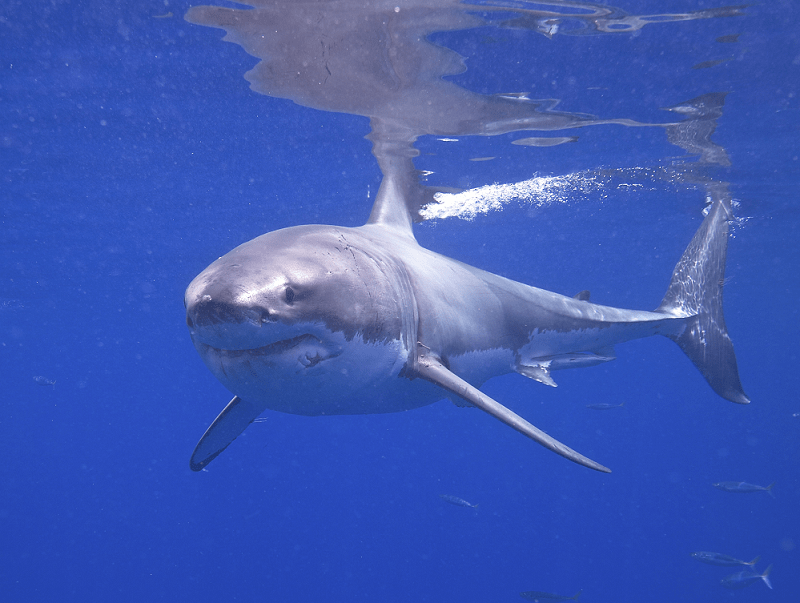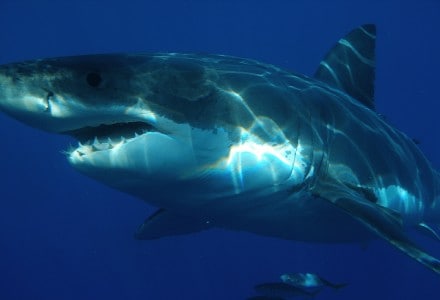
Great White Shark Facts
- The term of Great White Shark serves as one of the common names for a truly incredible variety of mackerel shark. This marvel of Nature also goes by the other common names, though, such as the great white, the white shark, and white pointer.
- In the meantime, it also has the tongue-twisting scientific name of the Carcharodon carcharias. But, regardless of what name one uses to refer to it, this magnficent creature represents one of the oceans primary apex predators.
- This incredibly efficient hunter also has almost no known predators of its own. This holds true throughout the entirety of its natural range. The rare exception, though, would be rare attacks by orcas when other, easier prey cannot be found.
- The breathtaking Great White Shark also exemplifies a very fast and far-ranging hunter. This true marvel of Nature has the ability to reach speeds measuring as much as 35 mph (56 kph). It can also safely dive to depths of as much as 3,900 ft (1,200 m).
- For a variety of reasons, the IUCN lists this majestic creature as Vulnerable. This holds true largely due to such factors as habitat loss and reduction of its prey, due to human commercial fishing practices. However, it also faces danger from climate change.
Related Articles
Blue Shark Greenland Shark Bull Shark
Great White Shark Physical Description
The remarkably impressive Great White Shark earns this status for several reasons, one of them being its sheer physical size. That’s because it attains a maximum known length of 20 ft (6 m) and weighs as much as roughly 5,000 pounds (2,268 kg).
It displays a visually striking color pattern. This holds true due to the fact that, most commonly, it appears grayish in color on the top part of its body and white underneath. In addition, just like many species of sharks, the Great White Shark has multiple rows of teeth.
Like all sharks, it also possesses a special sensory organ which allows it to detect the electromagnetic fields generated by the movement of living animals. In this species, this sense seems to be rather especially acute, allowing it to detect a field of half a billionth volt.
- Kingdom: Animalia
- Phylum: Chordata
- Class: Chondrichthyes
- Order: Lamniformes
- Family: Lamnidae
- Genus: Carcharodon
- Species: C. carcharias
Great White Shark Distribution, Habitat, and Ecology
It bears mentioning that the remarkable Great White Shark has more advantages than just its physical attributes. That holds true because it possesses an almost global range of habitation. This gives it a decided advantage over many species.
As a result, this truly amazing fish inhabits virtually all temperate and tropical waters. This fact often amazes those who encounter it. But, the greatest known concentration of its numbers presently occurs in the waters off the coast of South Africa, in Africa.
The incredibly powerful predator most commonly appears in coastal and offshore areas. This practice, quite unfortunately, frequently leads to encounters with humans. There, though, it rarely, though not never, enters waters with depths of less than 1,000 ft (305 m).
This extremely dangerous creature much more commonly appears at great depths, however. These often reach as deep as 3,900 ft (1,200 m). Additionally, with an average lifespan of 25 – 30 years, it generally prefers to stalk a regular territory.
Given its power and speed, the supremely effective predator quite understandably feeds on a wide variety of prey. In point of fact, this monstrously powerful, and also highly aggressive, hunter will feed on virtually any creature it can find.
The Great White Shark nevertheless does tend to have certain preferences for its choice of prey, as nearly all creatures do. More specifically, these include tuna, dolphins, seals, sea turtles, sea otters, and even, when possible, marine birds.
Species Sharing Its Range
Check out our other articles on Shark-Finning Whims, African Penguin, Socotra, Brazilian Wandering Spider, Leaping Lesbian Lizard, Hogenakkal Falls, Giant Hogweed

